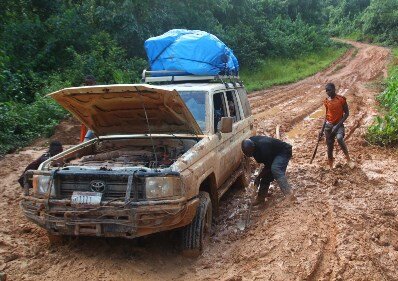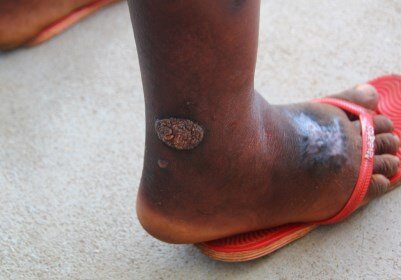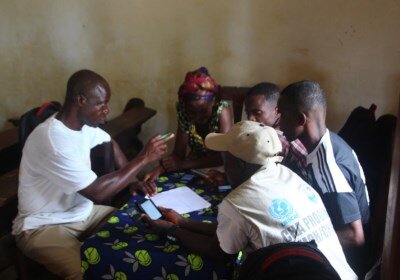Case finding NTDs in Liberia's rainy season

Over the past six months LSHTM's London Applied & Spatial Epidemiology Research (LASER) team have been working alongside the national Neglected Tropical Disease (NTD) programme of Liberia and the AIM Initiative to develop new case finding tools to find those suffering with a range of NTDs of the skin. LASER's Joseph Timothy highlights some of the challenges encountered by the field teams in rainy Maryland County.
Successful case finding is a cornerstone of many health programmes, irrespective of where you are or what resources you have. The ultimate goal is to identify everyone possible with the disease of interest. However, the diverse diseases and local situations that play out all over the world mean that case finding can look very different from one place to another. Offering mammograms to all UK women aged 50 to 70 in specialist breast screening units represents one example of case finding. Walking door-to-door through tropical Liberian forests showing pictures of skin NTDs is a very different approach. Yet both are striving towards the same goal.
Liberia is burdened by a number of long-lasting and disfiguring NTDs that affect the skin. Finding them, however, is difficult. Many of those affected live in remote communities who lack access to high quality health care, as well as most other things we associate with development. Some skin NTDs also occur most often during periods of rain and high humidity, so this can be a good time to look. This must be balanced against the additional logistical demands of the wet season, as the use of cars quickly becomes unfeasible, then, as rains intensify, even motorbikes stop being useful. At this point walking can become the only reliable way of reaching affected communities.

For our survey, the workforce given the task of door-to-door case finding during these long months is the local community health worker (CHW) cadre. Across Liberia, nearly all villages elect one or more CHWs as part of a national programme to improve access to healthcare in hard-to-reach populations. These are probably the only people with the combination of local knowledge and toughness to get this job done.
To ensure nobody was left behind during our case finding activities, each CHW was held responsible for visiting every last family in their community to look for skin NTDs. A team of nationally trained expert verifiers then had to visit the community of every potential case. This strategy entailed long periods of work in very remote areas with no electricity or network coverage. As the rivers swelled, moving people and equipment over large distances proceeded ever more slowly, and with greater risks. All this created serious challenges, as the project depended upon real-time mobile electronic data collection and GPS information to monitor every moment of field activities in fine detail.

To overcome these obstacles, the field teams were forced to come up with a number of both high and low-tech fixes. This included kitting out every field worker with high capacity power banks, so they can work unimpeded for extended periods in the bush. We also provided dry bags normally reserved for kayaking expeditions, so that even the CHWs who needed to swim across rivers to get home could do so without jeopardising their equipment. A lack of mobile data coverage presented an almost insurmountable challenge at times. An ad-hoc network of collection points, bike couriers and mobile hotspots did, however, facilitate a network of smartphones moving across the county that enabled regular data monitoring.
Despite these challenges, CHWs achieved laudable coverage of their communities. Their case-finding activities also provided an essential link between each newly identified patient and their local health facility, ensuring that patients were able to receive appropriate treatment. Through their tireless efforts, the CHWs have helped ensure that their remote communities are one (rain-booted) step closer to achieving the ultimate goal of Universal Health Coverage.
This work is carried out as part of the 'Integrated Mapping of Skin-presenting Neglected Tropical Diseases in Liberia' research project funded by the Aim Initiative. The project is a collaboration between researchers at the LSHTM (Rachel Pullan, Joseph Timothy, Michael Marks, Steve Walker, & Katherine Halliday) and Liberia Ministry of Health (PI: Karsor Kollie)